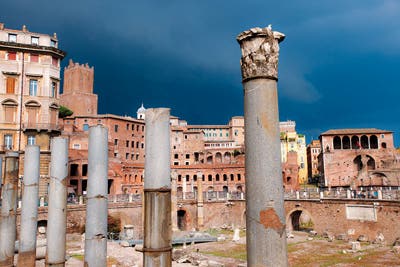
Ancient Marvel
I'd never paid much attention to Trajan's Market, a great, semicircular complex of ruins near the Colosseum in Rome (near via dei Fori Imperiali). Having spent years studying the origins of Mediterranean cuisine, I'd read about this wonder of antiquity, completed in A.D. 110, during the reign of the Emperor Trajan, but I'd always been too busy admiring Rome's other splendors to really examine it. On a recent visit, though, I paused before the structure, with its arched entryways and recessed rooms, and imagined myself an ancient Roman citizen, browsing the stalls, taverns, and shops that occupied these roughly five-acre grounds 2,000 years ago.
What would have been on my shopping list? Modern-day Italian staples like pasta and tomatoes were unknown in ancient Rome, and offal such as sow's womb and bacon-wrapped pig bowels were delicacies, as was fresh fish. I thought of a charismatic recipe I'd found in the writings of Marcus Gavius Apicius, a Roman epicure from the first century A.D. It called for grilling whole fish in a pungent marinade of black pepper, coriander seeds, dried mint, celery seeds, onions, raisins, honey, vinegar, wine, and oil. Trying to recall all I'd read about the Mercatus Traiani, I began to picture what it might have been like to shop for that dish here.
First, I would have stopped at a piscatorium, or fishmonger's shop, located on the first floor of the market alongside the macellarii, or butchers. I would have chosen from among the shop's live fish, delivered fresh from the nearby harbor city of Ostia and displayed in stone tanks fed by an ingenious plumbing system that delivered saltwater from the coast. I'd have handed the fishmonger a few denarii, the heavy silver coins that were the era's imperial currency, for my purchase and then headed to the market's second floor, which housed shops selling oils and wines. Walking through the well-preserved ruins on that last visit to Rome, I could see where a wine shop once stood: the room still had a hole in the floor where spilled wine could drain—a reminder of how brisk business must have been in thirsty ancient Rome.
I envisioned myself choosing from dozens of strong red wines, stored in earthenware amphorae and meant to be diluted with water; for such a lavish dish I might have asked for one of the especially potent wines from Falernum, made with grapes from which modern-day aglianico is thought to be descended. Next I'd have followed the pungent aroma to a vendor selling liquamen, also called garum, the typical flavoring of ancient Rome and an ancestor of Worcestershire sauce; made of fermented anchovies and fish entrails, the dark-colored liquid probably resembled modern-day Southeast Asian fish sauce. On the third level were the sellers of spices and dried goods, where I'd have purchased precious black pepper, imported from India, and the other flavorings for my grilled fish. Haggling—and, in the event of a disagreement, appealing to the market's aedile, an arbitrator whose sole duty was to resolve disputes—I'd have assembled the ingredients for a splendid supper.
My ideal dining companion for the feast? The Roman satirist Juvenal, a contemporary of Trajan whose biting critiques painted a vivid picture of Roman society. Famous for his maxim that Romans cared more about "bread and circuses" than civic affairs, Juvenal, I've always thought, would have understood me
well. —Clifford A. Wright, author of A Mediterranean Feast (William Morrow, 1999)
Keep Reading
Continue to Next Story










